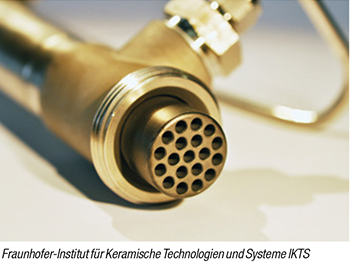Membranes separate H2 from CH4, CO2 from industrial gases
 This institute has developed a technology based on carbon membranes that can be used to efficiently separate hydrogen and natural gas, thereby enabling both gases to be transported together through natural gas networks and subsequently separated from each other as needed at the destination. Compared to pressure-swing adsorption (PSA) or cryogenic separation processes, this variant is said to be cost-effective and resistant to harsh ambient conditions and natural gas byproducts, such as H2S. The membranes can concentate 5 vol.% H2 in the feed to significantly more than 90 vol.% H2 in the permeate. Due to their excellent stability even at high temperatures, the carbon membranes are also suitable for the separation of CO2 from industrial gases. During test runs at relevant CO2 emitters (steel, lime and dolomite works, biogas plants), CO2 concentrations of more than 97% could be achieved. This makes it possible to further utilize the separated CO2 as a raw material for non-fossil fuels or chemicals, for example. Hall 7, Stand L36 — Fraunhofer-Institut für Keramische Technologien und Systeme IKTS, Hermsdorf, Germany
This institute has developed a technology based on carbon membranes that can be used to efficiently separate hydrogen and natural gas, thereby enabling both gases to be transported together through natural gas networks and subsequently separated from each other as needed at the destination. Compared to pressure-swing adsorption (PSA) or cryogenic separation processes, this variant is said to be cost-effective and resistant to harsh ambient conditions and natural gas byproducts, such as H2S. The membranes can concentate 5 vol.% H2 in the feed to significantly more than 90 vol.% H2 in the permeate. Due to their excellent stability even at high temperatures, the carbon membranes are also suitable for the separation of CO2 from industrial gases. During test runs at relevant CO2 emitters (steel, lime and dolomite works, biogas plants), CO2 concentrations of more than 97% could be achieved. This makes it possible to further utilize the separated CO2 as a raw material for non-fossil fuels or chemicals, for example. Hall 7, Stand L36 — Fraunhofer-Institut für Keramische Technologien und Systeme IKTS, Hermsdorf, Germany